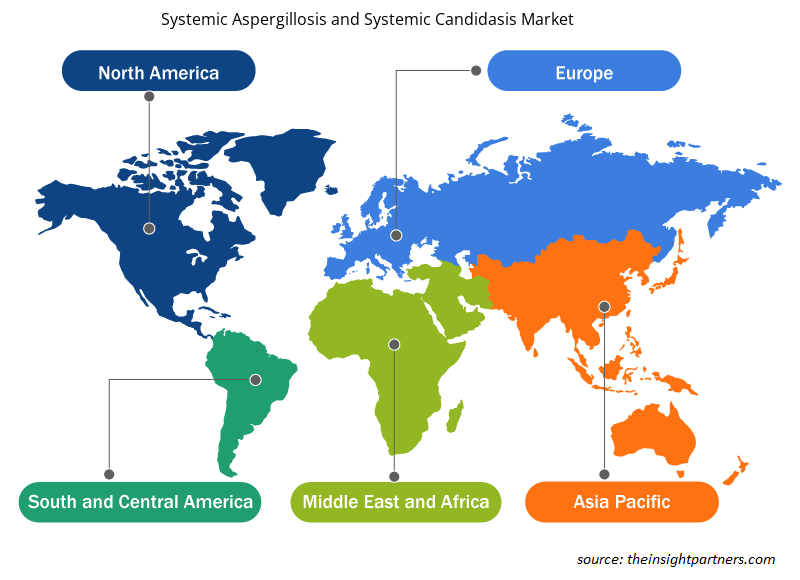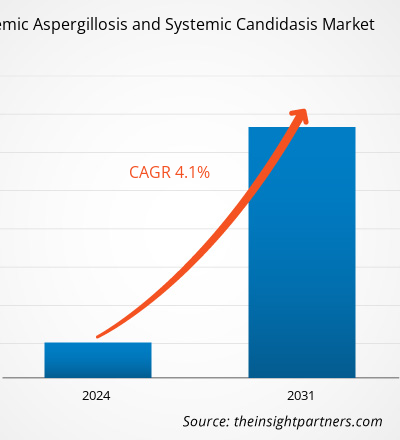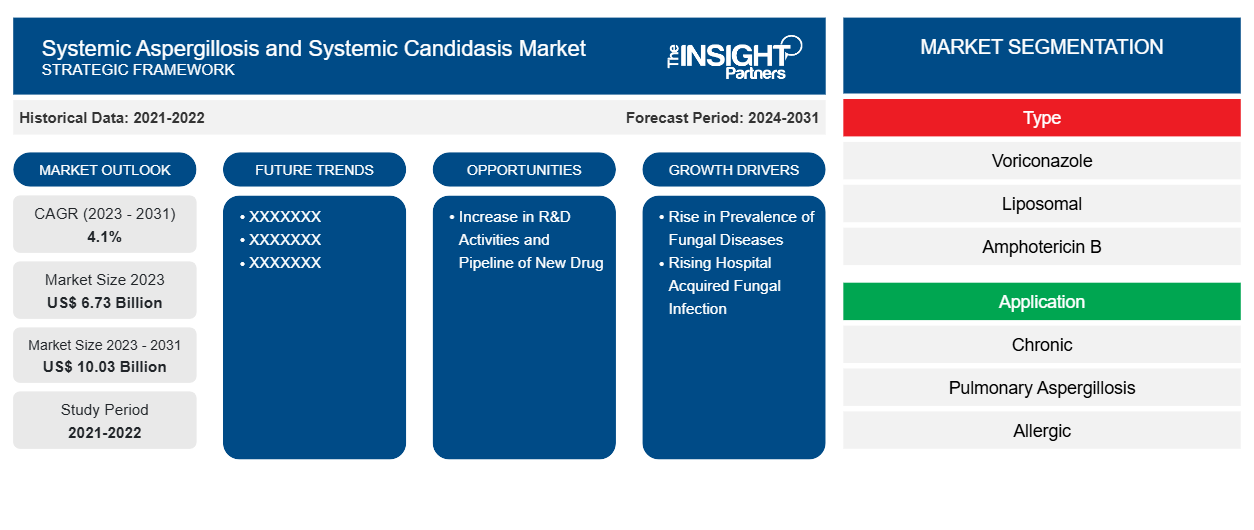Se proyecta que el tamaño del mercado de aspergilosis sistémica y candidiasis sistémica alcance los 10.030 millones de dólares estadounidenses para 2031, frente a los 6.730 millones de dólares estadounidenses en 2023. Se espera que el mercado registre una CAGR del 4,1 % entre 2023 y 2031. Es probable que el desarrollo de nuevas terapias para el tratamiento de enfermedades fúngicas, el aumento de las actividades de I+D para el desarrollo de fármacos y el aumento de las enfermedades fúngicas adquiridas en el hospital sigan siendo tendencias clave del mercado de aspergilosis sistémica y candidiasis sistémica.
Análisis del mercado de la aspergilosis sistémica y la candidiasis sistémica
La prevalencia de la aspergilosis sistémica y la candidiasis sistémica está aumentando debido al aumento de los problemas de salud. A medida que el sistema inmunológico se debilita debido a la pandemia del VIH/SIDA, la tuberculosis, la enfermedad pulmonar obstructiva crónica (EPOC), el asma y la creciente incidencia de cánceres, el paciente es más susceptible a las enfermedades fúngicas. Por lo tanto, el aumento de la prevalencia de enfermedades que debilitan el sistema inmunológico está impulsando el crecimiento del mercado de la aspergilosis sistémica y la candidiasis sistémica.
Descripción general del mercado de aspergilosis sistémica y candidiasis sistémica
Las infecciones sistémicas fúngicas son comunes en pacientes con un sistema inmunológico debilitado, incluidos los pacientes inmunodeprimidos y con síndrome de inmunodeficiencia adquirida (SIDA). Los signos sistémicos incluyen apnea, heces guayacol positivas, distensión abdominal, hiperglucemia, reacción leucemoide, hipotensión y otros. El tratamiento de la candidiasis sistémica y la aspergilosis requiere terapia antimicótica parenteral y esta afección se asocia con una alta tasa de mortalidad. Además, esta infección puede provocar déficits permanentes del desarrollo neurológico en los sobrevivientes a largo plazo.
Personalice este informe según sus necesidades
Obtendrá personalización en cualquier informe, sin cargo, incluidas partes de este informe o análisis a nivel de país, paquete de datos de Excel, así como también grandes ofertas y descuentos para empresas emergentes y universidades.
-
Obtenga las principales tendencias clave del mercado de este informe.Esta muestra GRATUITA incluirá análisis de datos, desde tendencias del mercado hasta estimaciones y pronósticos.
Factores impulsores y oportunidades del mercado de la aspergilosis sistémica y la candidiasis sistémica
El aumento de infecciones fúngicas adquiridas en hospitales favorece el mercado
Candida Auris es un hongo que causa una grave amenaza para la salud mundial. C. Auris causa enfermedades graves en pacientes hospitalizados en varios países, incluido Estados Unidos. Pacientes C. auris ha causado brotes en centros de salud y puede propagarse a través del contacto con pacientes afectados y superficies o equipos contaminados. puede permanecer colonizado con C. Auris durante mucho tiempo, y C. Auris puede persistir en superficies en entornos de atención médica. Esto puede resultar en la propagación de C. Auris entre pacientes en centros de atención médica. Según un informe de los CDC de 2021, se han encontrado casos estadounidenses de C. Auris en pacientes que habían estado recientemente en centros de atención médica en Egipto, India, Kenia, Kuwait, Pakistán, Sudáfrica, Corea del Sur, los Emiratos Árabes Unidos y Venezuela, que también tienen casos documentados.Auris is a fungus that causes a serious global health threat. C. Auris causes severe illness in hospitalized patients in several countries, including the United States. Patients C. auris has caused outbreaks in healthcare facilities and can spread through contact with affected patients and contaminated surfaces or equipment. can remain colonized with C. Auris for a long time, and C. Auris can persist on surfaces in healthcare environments. This can result in the spread of C. Auris between patients in healthcare facilities. According to a CDC report of 2021, U.S. cases of C. Auris have been found in patients who had recent stays in healthcare facilities in Egypt, India, Kenya, Kuwait, Pakistan, South Africa, South Korea, the United Arab Emirates, and Venezuela, which also have documented cases.
Análisis de la cadena de producción: una oportunidad para la personalización de la aspergilosis sistémica y la candidiasis sistémicaCustomisation of Systemic Aspergillosis and Systemic Candidasis
El panorama actual de la aspergilosis sistémica y la candidiasis sistémica es prometedor, con múltiples aprobaciones de fármacos, una amplia cartera de productos y muchos ensayos clínicos en curso. Las carteras de productos para la aspergilosis sistémica y la candidiasis sistémica se encuentran en diversas etapas de desarrollo clínico; las principales compañías farmacéuticas están trabajando para avanzar en el espacio de la cartera y el potencial de crecimiento futuro del dominio competitivo de la aspergilosis sistémica y la candidiasis sistémica. Por ejemplo, el citrato de ibrexafungerp, un fármaco para el tratamiento de la candidiasis sistémica, se encuentra actualmente en la fase III y lo está desarrollando Scynexis.aspergillosis and systemic candidasis is promising, with multiple drug approvals, a rich pipeline, and many ongoing clinical trials. Pipelines of systemic aspergillosis and systemic candidasis are in various stages of clinical development; major pharmaceutical companies are working to advance the pipeline space and future growth potential of the systemic aspergillosis and systemic candidasis competitive domain. For instance, Ibrexafungerp Citrate, a drug for treatment of systemic candidiasis, is currently in phase III and is developed by Scynexis.
Análisis de segmentación del informe de mercado de aspergilosis sistémica y candidiasis sistémicaAspergillosis and Systemic Candidasis Market Report Segmentation Analysis
Los segmentos clave que contribuyeron a la derivación del análisis del mercado de aspergilosis sistémica y candidiasis sistémica son el tipo y la aplicación.Aspergillosis and Systemic Candidasis Market analysis are type and application.
- Según el tipo, el mercado de aspergilosis sistémica y candidiasis sistémica se divide en voriconazol, anfotericina b liposomal, azoles orales sistémicos, agentes antimicóticos tópicos y otros. El segmento de azoles orales sistémicos tuvo la mayor participación de mercado en 2023. Los medicamentos azólicos orales como fluconazol, ketoconazol e itraconazol han tenido un gran avance en la terapia antimicótica sistémica. Entre los tres, el fluconazol tiene el perfil farmacológico (farmacocinética y farmacodinámica) más atractivo, incluida la capacidad de producir altas concentraciones de fármaco activo en el líquido cefalorraquídeo y la orina.Aspergillosis and Systemic Candidasis Market is divided into voriconazole, liposomal amphotericin b, systemic oral azoles, topical antifungal agents and others. The systemic oral azoles segment held the largest market share in 2023. Oral azole drugs such as fluconazole, ketoconazole, and itraconazole have a major advancement in systemic antifungal therapy. Among all the three, fluconazole has the most attractive pharmacologic (pharmacokinetics and pharmacodynamic) profile, including the capacity to produce high concentrations of active drug in cerebrospinal fluid and urine.
- Por aplicación, el mercado está segmentado en aspergilosis pulmonar crónica (APC), aspergilosis broncopulmonar alérgica (ABPA), candidiasis gastrointestinal , candidiasis del tracto genitourinario y otras. El segmento de aspergilosis broncopulmonar alérgica (ABPA) tuvo la mayor participación del mercado en 2023.
Análisis de la cuota de mercado de la aspergilosis sistémica y la candidiasis sistémica por geografía
El alcance geográfico del informe de mercado de aspergilosis sistémica y candidiasis sistémica se divide principalmente en cinco regiones: América del Norte, Asia Pacífico, Europa, Medio Oriente y África, y América del Sur / América del Sur y Central.
América del Norte ha dominado el mercado de la aspergilosis sistémica y la candidiasis sistémica. El crecimiento del mercado de la región se atribuye a la creciente incidencia de infecciones fúngicas y al creciente desarrollo y lanzamiento de productos, y al aumento de iniciativas sobre infecciones fúngicas y sus tratamientos. Además, se espera que los crecientes gastos de salud para el tratamiento de las infecciones fúngicas impulsen el crecimiento del mercado durante el período de pronóstico hasta el dominio del mercado de aspergilosis sistémica y candidiasis sistémica de América del Norte. Se estima que Estados Unidos es el mercado más grande para la aspergilosis sistémica y la candidiasis sistémica. El crecimiento se atribuye a la creciente incidencia de infecciones fúngicas que alientan aún más a varias compañías farmacéuticas a invertir en sus programas de I+D e introducir medicamentos de tratamiento innovadores en el mercado. Por ejemplo, en enero de 2020, Astellas Pharma Inc. anunció que había recibido la aprobación de la FDA para su solicitud complementaria de nuevo fármaco (sNDA) para MYCAMINE (micafungina inyectable). Se prevé que Asia Pacífico crezca con la CAGR más alta en los próximos años.
Perspectivas regionales del mercado de aspergilosis sistémica y candidiasis sistémica
Los analistas de Insight Partners explicaron en detalle las tendencias y los factores regionales que influyen en el mercado de aspergilosis sistémica y candidiasis sistémica durante el período de pronóstico. Esta sección también analiza los segmentos y la geografía del mercado de aspergilosis sistémica y candidiasis sistémica en América del Norte, Europa, Asia Pacífico, Oriente Medio y África, y América del Sur y Central.

- Obtenga datos regionales específicos para el mercado de aspergilosis sistémica y candidiasis sistémica
Alcance del informe de mercado sobre aspergilosis sistémica y candidiasis sistémica
| Atributo del informe | Detalles |
|---|---|
| Tamaño del mercado en 2023 | 6.730 millones de dólares estadounidenses |
| Tamaño del mercado en 2031 | US$ 10.03 mil millones |
| CAGR global (2023 - 2031) | 4,1% |
| Datos históricos | 2021-2022 |
| Período de pronóstico | 2024-2031 |
| Segmentos cubiertos |
Por tipo
|
| Regiones y países cubiertos |
América del norte
|
| Líderes del mercado y perfiles de empresas clave |
|
Densidad de actores del mercado: comprensión de su impacto en la dinámica empresarial
El mercado de la aspergilosis sistémica y la candidiasis sistémica está creciendo rápidamente, impulsado por la creciente demanda de los usuarios finales debido a factores como la evolución de las preferencias de los consumidores, los avances tecnológicos y una mayor conciencia de los beneficios del producto. A medida que aumenta la demanda, las empresas amplían sus ofertas, innovan para satisfacer las necesidades de los consumidores y aprovechan las tendencias emergentes, lo que impulsa aún más el crecimiento del mercado.
La densidad de actores del mercado se refiere a la distribución de las empresas o firmas que operan dentro de un mercado o industria en particular. Indica cuántos competidores (actores del mercado) están presentes en un espacio de mercado determinado en relación con su tamaño o valor total de mercado.
Las principales empresas que operan en el mercado de aspergilosis sistémica y candidiasis sistémica son:
- Novartis AG
- Sanofi Aventis
- Pfizer, Inc
- Merck y Co., Inc.
- Enzon Pharmaceuticals, Inc
- Bayer AG
Descargo de responsabilidad : Las empresas enumeradas anteriormente no están clasificadas en ningún orden particular.

- Obtenga una descripción general de los principales actores clave del mercado de aspergilosis sistémica y candidiasis sistémica
Noticias y desarrollos recientes del mercado de aspergilosis sistémica y candidiasis sistémica
El mercado de la aspergilosis sistémica y la candidiasis sistémica se evalúa mediante la recopilación de datos cualitativos y cuantitativos posteriores a la investigación primaria y secundaria, que incluye publicaciones corporativas importantes, datos de asociaciones y bases de datos. A continuación, se incluye una lista de los avances en el mercado de la aspergilosis sistémica y la candidiasis sistémica y las estrategias:
- Pfizer adquirió Amplyx Pharmaceuticals, Inc. Pfizer se ha asegurado la propiedad de la línea de productos en fase inicial de Amplyx, que incluye posibles terapias antivirales (MAU868) y antimicóticas (APX2039). (Fuente: Pfizer, comunicado de prensa, 2021)
- Basilea Pharmaceutica Ltd ha firmado un acuerdo de compra de activos con Amplyx Pharmaceuticals, Inc., una filial de Pfizer Inc., que ha adquirido los derechos de fosmanogepix, un candidato antimicótico de amplio espectro en fase clínica. Además, Basilea ha adquirido los derechos de un compuesto antimicótico preclínico. (Fuente: Biospace, nota de prensa, 2023)
Informe de mercado sobre aspergilosis sistémica y candidiasis sistémica: cobertura y resultados
El informe “Tamaño y pronóstico del mercado de aspergilosis sistémica y candidiasis sistémica (2021-2031)” proporciona un análisis detallado del mercado que cubre las siguientes áreas:
- Tamaño del mercado y pronóstico a nivel global, regional y nacional para todos los segmentos clave del mercado cubiertos bajo el alcance
- Dinámica del mercado, como impulsores, restricciones y oportunidades clave
- Principales tendencias futuras
- Análisis detallado de las cinco fuerzas de Porter y PEST y FODA
- Análisis del mercado global y regional que cubre las tendencias clave del mercado, los principales actores, las regulaciones y los desarrollos recientes del mercado.
- Análisis del panorama de la industria y de la competencia que abarca la concentración del mercado, el análisis de mapas de calor, los actores destacados y los desarrollos recientes
- Perfiles detallados de empresas
- Análisis histórico (2 años), año base, pronóstico (7 años) con CAGR
- Análisis PEST y FODA
- Tamaño del mercado, valor/volumen: global, regional y nacional
- Industria y panorama competitivo
- Conjunto de datos de Excel
Informes recientes
Testimonios
Razón para comprar
- Toma de decisiones informada
- Comprensión de la dinámica del mercado
- Análisis competitivo
- Información sobre clientes
- Pronósticos del mercado
- Mitigación de riesgos
- Planificación estratégica
- Justificación de la inversión
- Identificación de mercados emergentes
- Mejora de las estrategias de marketing
- Impulso de la eficiencia operativa
- Alineación con las tendencias regulatorias























 Obtenga una muestra gratuita para - Mercado de aspergilosis sistémica y candidiasis sistémica
Obtenga una muestra gratuita para - Mercado de aspergilosis sistémica y candidiasis sistémica